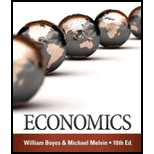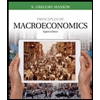
(a)
To compute:
The maximum increase in the money supply, if the reserve requirement is
Answer to Problem 15E
If the reserve requirement is
Explanation of Solution
Given information:
The banking system has vault cash of
As in the
Total liabilities are of $10,000.
Calculation for increase in money supply:
Working Note:
Calculation for the required reserve:
Calculation for the excess reserve by calculating total legal reserve:
Now, calculation of excess reserve:
Calculation for the deposit expansion multiplier:
It refers to a certain amount of cash from the deposit that a bank needs to keep according to the guidelines of the central bank.
Required reserve is calculated by,
Here, RR is reserve, r is percentage of required reserve and D is the total amount in deposits.
Excess reserve:
It refers to the amount left after separating the required reserve ratio of the financial institution.
(b)
To compute:
The
Answer to Problem 15E
The excess reserve of the banking system after Fed buys $100 bonds $900.
The maximum increase in money supply after the Fed buys $100 bonds is $4,500.
Explanation of Solution
Given information:
The banking system has vault cash of
According to the given information, the change in balance sheet after the Fed buys the
| Particulars | Amount ($) | Particulars | Amount ($) |
| Vault Cash | Demand deposits | ||
| Deposit in Fed | $2,000 | ||
| Bonds | $100 | ||
| Loan | |||
| Total |
Table (1)
Calculation for excess reserve:
Therefore, the excess reserve would be $900.
Calculation for increase in money supply:
The maximum increase in money supply after the Fed buys
Working Note:
Calculation for the required reserve.
Calculation of the excess reserve by determining total legal reserve.
To calculate maximum increase in the money supply, calculate the deposit expansion multiplier.
Required reserve:
It refers to the certain amount of cash from the deposit that a bank needs to keep according to the guidelines of the central bank.
Required reserve is calculated by,
Here, RR is reserve, r is percentage of required reserve and D is the total amount in deposits.
Excess reserve:
It refers to the amount left after separating the required reserve ratio of the financial institution.
Want to see more full solutions like this?
- As indicated in the attached image, U.S. earnings for high- and low-skill workers as measured by educational attainment began diverging in the 1980s. The remaining questions in this problem set use the model for the labor market developed in class to walk through potential explanations for this trend. 1. Assume that there are just two types of workers, low- and high-skill. As a result, there are two labor markets: supply and demand for low-skill workers and supply and demand for high-skill workers. Using two carefully drawn labor-market figures, show that an increase in the demand for high skill workers can explain an increase in the relative wage of high-skill workers. 2. Using the same assumptions as in the previous question, use two carefully drawn labor-market figures to show that an increase in the supply of low-skill workers can explain an increase in the relative wage of high-skill workers.arrow_forwardPublished in 1980, the book Free to Choose discusses how economists Milton Friedman and Rose Friedman proposed a one-sided view of the benefits of a voucher system. However, there are other economists who disagree about the potential effects of a voucher system.arrow_forwardThe following diagram illustrates the demand and marginal revenue curves facing a monopoly in an industry with no economies or diseconomies of scale. In the short and long run, MC = ATC. a. Calculate the values of profit, consumer surplus, and deadweight loss, and illustrate these on the graph. b. Repeat the calculations in part a, but now assume the monopoly is able to practice perfect price discrimination.arrow_forward
- how commond economies relate to principle Of Economics ?arrow_forwardCritically analyse the five (5) characteristics of Ubuntu and provide examples of how they apply to the National Health Insurance (NHI) in South Africa.arrow_forwardCritically analyse the five (5) characteristics of Ubuntu and provide examples of how they apply to the National Health Insurance (NHI) in South Africa.arrow_forward
 Essentials of Economics (MindTap Course List)EconomicsISBN:9781337091992Author:N. Gregory MankiwPublisher:Cengage Learning
Essentials of Economics (MindTap Course List)EconomicsISBN:9781337091992Author:N. Gregory MankiwPublisher:Cengage Learning Principles of Economics (MindTap Course List)EconomicsISBN:9781305585126Author:N. Gregory MankiwPublisher:Cengage Learning
Principles of Economics (MindTap Course List)EconomicsISBN:9781305585126Author:N. Gregory MankiwPublisher:Cengage Learning Brief Principles of Macroeconomics (MindTap Cours...EconomicsISBN:9781337091985Author:N. Gregory MankiwPublisher:Cengage Learning
Brief Principles of Macroeconomics (MindTap Cours...EconomicsISBN:9781337091985Author:N. Gregory MankiwPublisher:Cengage Learning Principles of Macroeconomics (MindTap Course List)EconomicsISBN:9781305971509Author:N. Gregory MankiwPublisher:Cengage Learning
Principles of Macroeconomics (MindTap Course List)EconomicsISBN:9781305971509Author:N. Gregory MankiwPublisher:Cengage Learning Exploring EconomicsEconomicsISBN:9781544336329Author:Robert L. SextonPublisher:SAGE Publications, Inc
Exploring EconomicsEconomicsISBN:9781544336329Author:Robert L. SextonPublisher:SAGE Publications, Inc Macroeconomics: Private and Public Choice (MindTa...EconomicsISBN:9781305506756Author:James D. Gwartney, Richard L. Stroup, Russell S. Sobel, David A. MacphersonPublisher:Cengage Learning
Macroeconomics: Private and Public Choice (MindTa...EconomicsISBN:9781305506756Author:James D. Gwartney, Richard L. Stroup, Russell S. Sobel, David A. MacphersonPublisher:Cengage Learning





